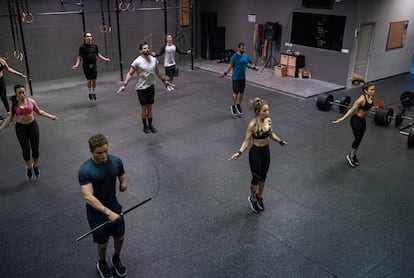How to start a sustainable exercise routine in September
The challenge lies in enjoying it and making it a daily habit. We start by analyzing the main reasons behind quitting

“I would like to be in shape. I would. But every time I try to get into shape, something goes wrong and makes it impossible. Let me make this clear: Every time I get into shape, something breaks,” Nora Ephron wrote in her book I Feel Bad About My Neck. This time of year evokes a classic comedy, Come September, in which Robert (Rock Hudson), a New York businessman, visits the Italian Riviera each September. There he maintains a relationship with Lisa (Gina Lollobrigida), though they only see each other one month of the year. Many people have a similar relationship with the gym: they only go in September.
The beginning of the school year brings a rush of motivation to begin new exercise routines. but most fail to maintain them through June. The best gym client is one who pays and never goes. But there are ways to avoid the seemingly inevitable end.
According to the World Health Organization, approximately 60% of the global population does not do enough physical exercise, which can bring serious health consequences. Each year between four and five million deaths could be avoided if people were more active. There is no strict definition of what constitutes a sedentary lifestyle, but researchers have some metrics to measure it. According to studies, spending four to six hours sitting or laying down is considered sedentary. If that is your case, the challenge involves learning to enjoy exercise and making it part of a daily routine. To do so, we can start by analyzing the primary reasons behind quitting.
Choosing activities that are inadequate for sedentary people
Someone who begins working out without sufficient planning is likely to end up injured or burnt out, without a desire to continue.
False expectations
But what many people imagine does not correspond to the results. Some people may believe that working out will get them into a certain physical shape. When they don’t, they get frustrated and quit. Before and after photos do not tend to be a good reference, though they are often used to obtain clients. Each body is different.
The search for shortcuts “Miracle” workouts, those that promise quick results with little effort, are everywhere. But getting in shape follows science. Results —like improving strength, resistance and body compositions— take time.
Choosing a personal trainer
“So far, in the breakage department, I have managed the following: I pulled my lower back doing sit-ups; I threw out my right hip on the treadmill; I got shin splints from jogging,” writes Ephron in her book. Why did that happen to her? If you want to solve a stomach problem, go to a digestion specialist. If you want to learn to eat healthier, make an appointment with a nutritionist. And if you want to start exercising? Look for a professional. A YouTube or Instagram video cannot evaluate your health, analyze your medical history and adapt your workout to your life circumstances. Studies show that individual personal training is an effective way to change attitudes and increase physical activity.
Imagine that you want to buy a suit. You buy one at the mall and have another one tailor-made. Which one will fit better? Personal training is like that tailored suit. The best exercise is the exercise that you do. To do it well, and maintain it beyond September, you could use professional help. Working out requires knowledge of physiology, biomechanics and training methods. Be sure that your trainer is professionally qualified. Social media is just the tip of the iceberg. A showy Instagram profile doesn’t reveal much. Ask about a trainer’s educational background, and pay attention to how they treat their clients. Look for a trainer that inspires you and has a good reputation, not just an influencer. And beware of free services. If a service is free, you are the product.
A personal trainer should be a companion in your journey, not a higher being that you should imitate. They should not judge you or make you feel guilty. They should adapt the exercise routine to you and not the other way around, using healthy and realistic expectations.
Teamwork is fundamental. Pay attention to the network of professionals around your trainer: cardiologists, physical therapists, endocrinologists, nutritionists, psychologists.
“I am now exercising again. I have a trainer. I have my treadmill. I have my TV set over the treadmill. I exercise almost four hours a week,” writes Nora Ephron. If you want to enjoy the health benefits of physical activity (cardiovascular, body composition, strength, autonomy, prevention of different types of cancer, diabetes, mental illness), give it a chance and find a trainer. Together you’ll find a way to avoid only visiting the gym in September.
From theory to practice
Prioritize safety and avoid injuries. Before you buy the latest sportswear, get a fitness exam done by a doctor in a clinical setting (not a gym). This should be the first step before practicing any physical activity.
For a beginner, starting an exercise routine can seem like entering a new universe. It is not easy, and each individual has different needs and preferences. Avoid comparing yourself to anyone. A sustainable exercise program should take into account your health, habits, preferences, context and needs.
Prioritize yourself and put order in your agenda. Find a space for self-care. If you don’t find room for health, you will have room for illness.
Whether at home, outdoors or at a sports facility, find your place. Where can you work out best? What is most comfortable for you? If you decide to train at home, ask for advice on what equipment you need and find a place to store it.
Invest in your health and ask for professional advice. Once you begin this journey, you will learn how to take care of yourself, and you will enjoy moving more and better.
Sign up for our weekly newsletter to get more English-language news coverage from EL PAÍS USA Edition
Tu suscripción se está usando en otro dispositivo
¿Quieres añadir otro usuario a tu suscripción?
Si continúas leyendo en este dispositivo, no se podrá leer en el otro.
FlechaTu suscripción se está usando en otro dispositivo y solo puedes acceder a EL PAÍS desde un dispositivo a la vez.
Si quieres compartir tu cuenta, cambia tu suscripción a la modalidad Premium, así podrás añadir otro usuario. Cada uno accederá con su propia cuenta de email, lo que os permitirá personalizar vuestra experiencia en EL PAÍS.
¿Tienes una suscripción de empresa? Accede aquí para contratar más cuentas.
En el caso de no saber quién está usando tu cuenta, te recomendamos cambiar tu contraseña aquí.
Si decides continuar compartiendo tu cuenta, este mensaje se mostrará en tu dispositivo y en el de la otra persona que está usando tu cuenta de forma indefinida, afectando a tu experiencia de lectura. Puedes consultar aquí los términos y condiciones de la suscripción digital.











































